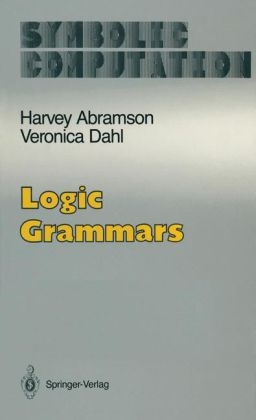
Logic Grammars
Springer-Verlag New York Inc. (Hersteller)
978-0-387-96961-9 (ISBN)
- Titel ist leider vergriffen;
keine Neuauflage - Artikel merken
0. Introduction and Historic Overview.- I. Grammars for Formal Languages and Linguistic Research.- 1. What are Logic Grammars.- 1. Logic Grammars — Basic Features.- 2. Grammar Symbols.- 3. Use of Variables and Unification.- 3.1. Unification.- 3.2. Derivation Graphs.- 3.3. Symbol Arguments: Producers and Consumers of Structure.- 4. Tests within Rules.- 5. Operators.- 6. Analysis and Generation.- 7. A Formal Language Example.- 2. Relation of Logic Grammars to Prolog.- 1. Basic Prolog Concepts.- 2. Prolog as a Language Recognizer.- 3. Prolog as a Structure Builder.- Bibliographic Commentary for Part I.- II. Getting Started: How to Write a Simple Logic Grammar.- 3. Step-by-Step Development of a Natural Language Analyser.- 1. Propositional Statements.- 2. Obtaining Representations for Propositional Statements.- 3. Syntactic and Semantic Agreement.- 4. Noun Phrases.- 5. Negative Sentences.- 6. Interrogative Clauses.- 4. Choosing Internal Representations for Natural Language.- 1. Logical Form for Querying Knowledge Represented in Logic.- 2. First-Order Logic Representations.- 2.1. Semantic Well Formedness.- 2.2. Ambiguity.- 2.3. Natural Language Determiners and Modifiers.- 2.3.1. Three-Branched Quantification.- 2.3.2. Quantifier Scoping.- 2.4. Negation.- 2.5. Meaning of Plural Forms.- 2.6. Representing Sets.- 3. Lambda-Calculus Representations.- 5. Developing a Logic Grammar for a Formal Application.- 1. An Analyzer for Logic Programs.- 2. Simple Lexical Analysis.- 3. Structural Representation of a Logic Program.- 4. “Compiling” Logic Programs.- 5. Compiling Proof Tree Generation into Rules.- Bibliographic Commentary for Part II.- III. Different Types of Logic Grammars — What Each Is Useful For.- 6. Basic Types of Logic Grammars.- 1. Metamorphosis Grammars.- 2. Definite Clause Grammars.- 3. Extraposition Grammars.- 4. Discussion.- 7. Building Structure.- 1. Parse Tree Construction.- 2. Meaning Representation Buildup.- 3. Automating Syntactic and Semantic Structure Buildup.- 8. Modifier Structure Grammars.- 1. Separation of Syntax and Semantics.- 2. Quantifier Rescoping.- 3. Coordination.- 4. Implementation.- 5. Discussion.- 9. Definite Clause Translation Grammars and their Applications.- 1. Definite Clause Translation Grammars.- 2. A Compiler.- 2.1. Introduction.- 2.2. Lexical Analysis.- 2.3. Between Lexical and Syntactic Analysis.- 2.4. Syntactic Analysis.- 2.5. Code Generation.- 2.5.1. The Target Machine.- 2.5.2. Code Generated for Statements.- 2.5.3. Code for Expressions.- 2.6. Assembly and Allocation.- 3. A Metagrammatical Extension of DCTG Notation.- 4. Grammatical Data Typing.- 4.1. The Natural Numbers.- 4.2. Lists.- 4.3. Trees.- 4.4. Infix and Prefix Notation.- 4.5. Comments on Grammatical Typing.- 10. Further Expressive Power — Discontinuous Grammars.- 1. The Discontinuous Grammar Family.- 2. Thinking in Terms of Skips — Some Examples.- 2.1. Coordination.- 2.2. Right Extraposition.- 2.3. Interaction between Different Discontinuous Rules.- 2.4. Avoiding Artifices through Straightforward Uses of Skips.- 2.5. Rules with More Than One Skip.- 2.6. DGs and Free Word Order Languages.- 2.6.1. Totally Free Word or Constituent Order.- 2.6.2. Lexically Induced Rule Format and Free Word Order.- 3. Static Discontinuity Grammars and Government-Binding Theory.- 3.1. Rendering Context-Free Simplicity with Type-0 Power.- 3.2. Government-Binding-Oriented Constraints.- 3.3. Definition.- 3.4. Implementation Considerations.- 3.5. Transporting the Static Discontinuity Feature into Logic Programming.- Bibliographic Commentary for Part III.- IV. Other Applications.- 11. Other Formalisms.- 1. Restriction Grammars.- 2. Puzzle Grammars.- 3. Discussion.- 12. Bottom Up Parsing.- 1. Introduction.- 2. Compiling Context-Free Rules.- Bibliographic Commentary for Part IV.- V. Logic Grammars and Concurrency.- 13. Parsing with Committment.- 1. Introduction.- 1.1. Sample Grammar.- 1.2. The One Character Lookahead Relation.- 2. Compilation to Sequential Logic Programs.- 3. Compilation to Concurrent Logic Program Clauses.- 4. Generalized Deterministic Grammars.- 5. Related Work.- 6. Parallel Parsing for Natural Language Analysis.- 6.1. Sample Grammar.- 6.2. Parallel Parsing Method.- Bibliographic Commentary for Part V.- Appendices.- I. Input/Output in Logic Grammars.- 1. Input of a Sentence.- II. Implementation of Logic Grammar Formalisms.- 1. SYNAL: Compiling Disc. Grammars to Prolog.- 2. A Short Interpreter for Static Discontinuity Grammars.- 3. Implementations of DCTGs.- 3.1. An Interpreter for Definite Clause Translation Grammars.- 3.2. Compiling Definite Clause Translation Grammars to Prolog.- 3.3. Typing DCTGs.- Literature.
| Zusatzinfo | Illustrations |
|---|---|
| Verlagsort | New York, NY |
| Sprache | englisch |
| Themenwelt | Informatik ► Theorie / Studium ► Künstliche Intelligenz / Robotik |
| ISBN-10 | 0-387-96961-6 / 0387969616 |
| ISBN-13 | 978-0-387-96961-9 / 9780387969619 |
| Zustand | Neuware |
| Informationen gemäß Produktsicherheitsverordnung (GPSR) | |
| Haben Sie eine Frage zum Produkt? |